ASS110-2: Data Collection Plan on Social Media and Teen Mental Health
VerifiedAdded on 2023/06/14
|13
|2725
|352
Project
AI Summary
This research project investigates the impact of social media on the mental health of teenagers. It identifies frequently used social media platforms, determines their effects on teenagers' mental well-being, and explores strategies to minimize negative impacts. The research employs a deductive approach, gathering primary data through questionnaires from a random sample of 20 teenagers. The findings reveal that while social media offers some positive aspects, it predominantly contributes to negative mental health outcomes such as increased anxiety, depression, cyberbullying, and sleep disturbances. Strategies like setting time limits and promoting offline activities are suggested to mitigate these adverse effects. The questionnaire data and its interpretations are provided, offering a detailed overview of the research process and findings.
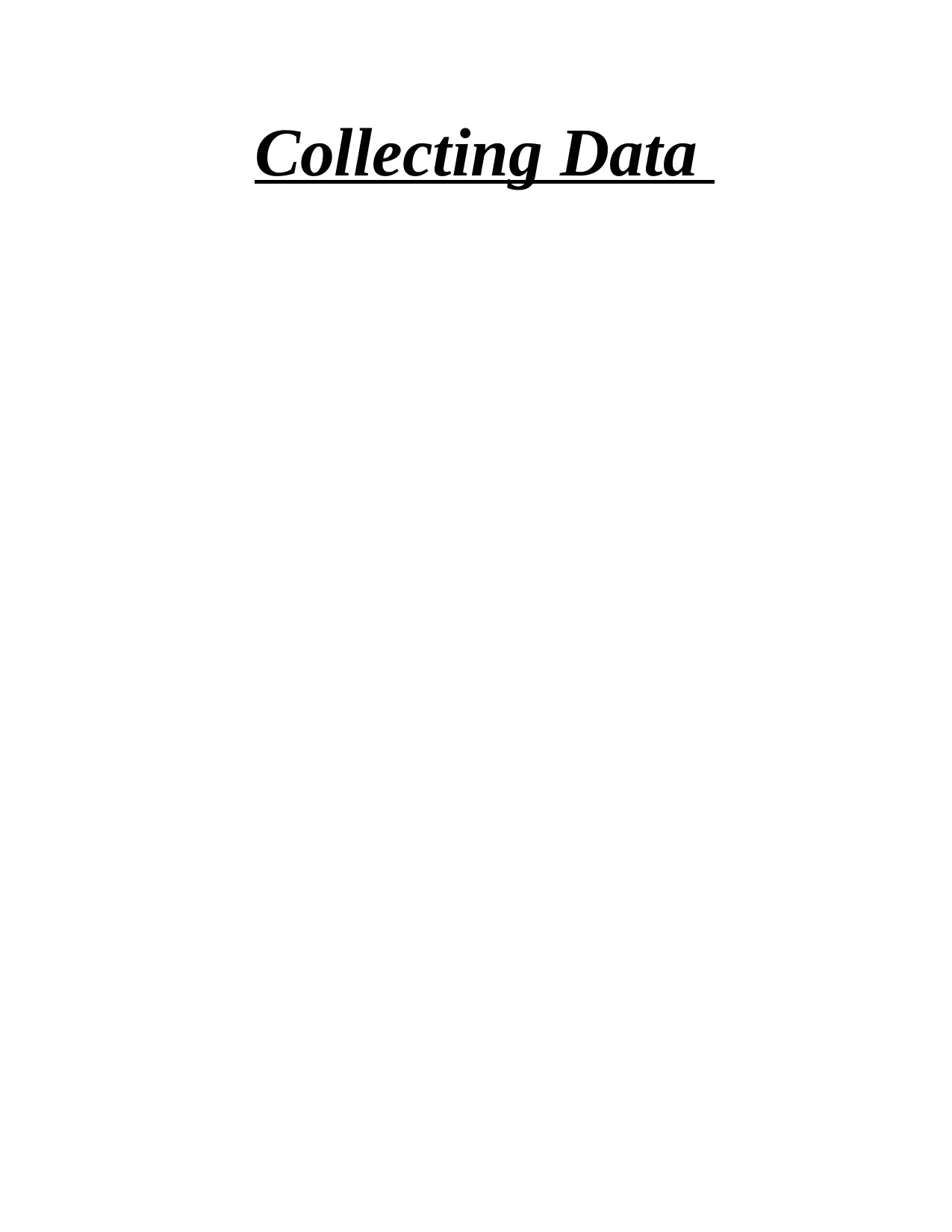
Collecting Data
Paraphrase This Document
Need a fresh take? Get an instant paraphrase of this document with our AI Paraphraser
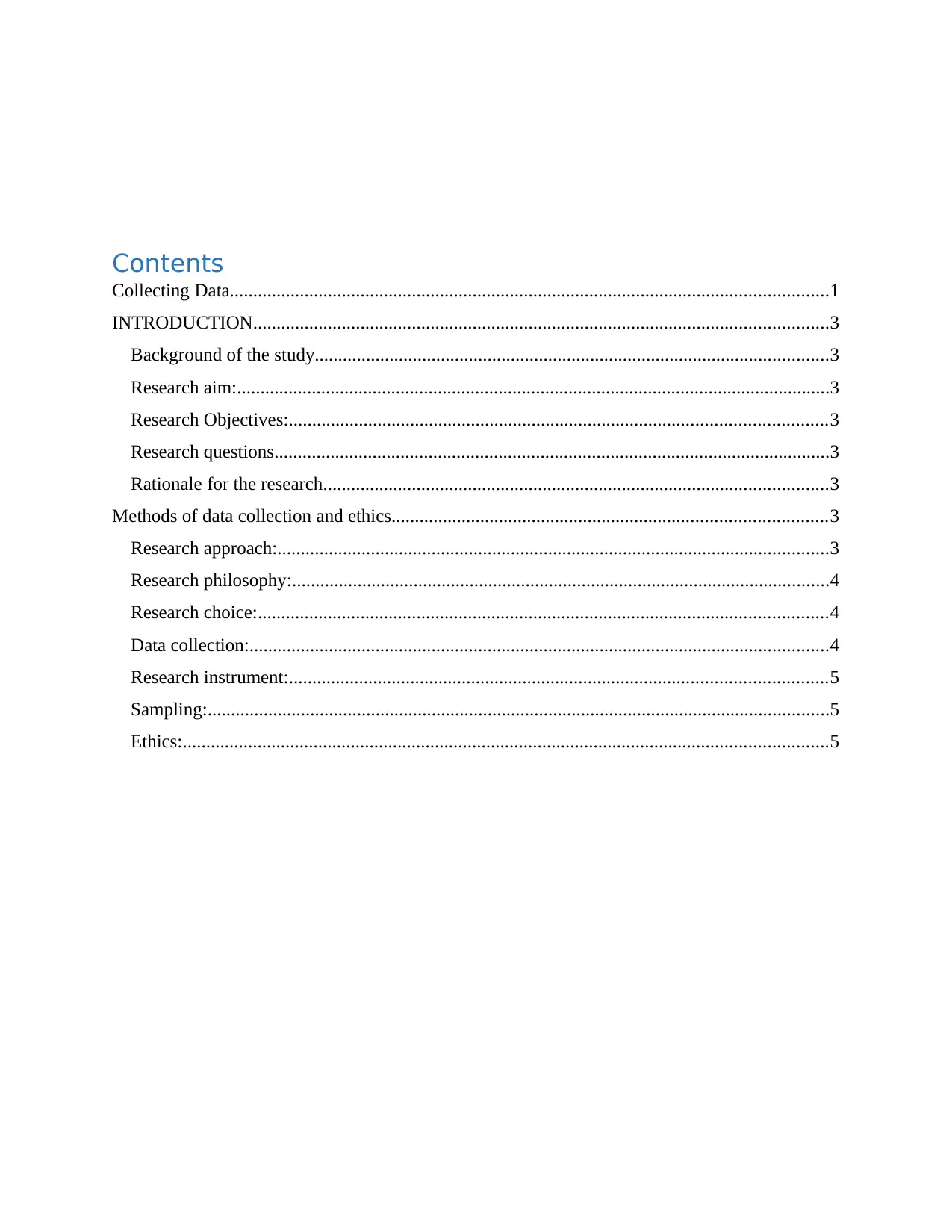
Contents
Collecting Data................................................................................................................................1
INTRODUCTION...........................................................................................................................3
Background of the study..............................................................................................................3
Research aim:...............................................................................................................................3
Research Objectives:...................................................................................................................3
Research questions.......................................................................................................................3
Rationale for the research............................................................................................................3
Methods of data collection and ethics.............................................................................................3
Research approach:......................................................................................................................3
Research philosophy:...................................................................................................................4
Research choice:..........................................................................................................................4
Data collection:............................................................................................................................4
Research instrument:...................................................................................................................5
Sampling:.....................................................................................................................................5
Ethics:..........................................................................................................................................5
Collecting Data................................................................................................................................1
INTRODUCTION...........................................................................................................................3
Background of the study..............................................................................................................3
Research aim:...............................................................................................................................3
Research Objectives:...................................................................................................................3
Research questions.......................................................................................................................3
Rationale for the research............................................................................................................3
Methods of data collection and ethics.............................................................................................3
Research approach:......................................................................................................................3
Research philosophy:...................................................................................................................4
Research choice:..........................................................................................................................4
Data collection:............................................................................................................................4
Research instrument:...................................................................................................................5
Sampling:.....................................................................................................................................5
Ethics:..........................................................................................................................................5
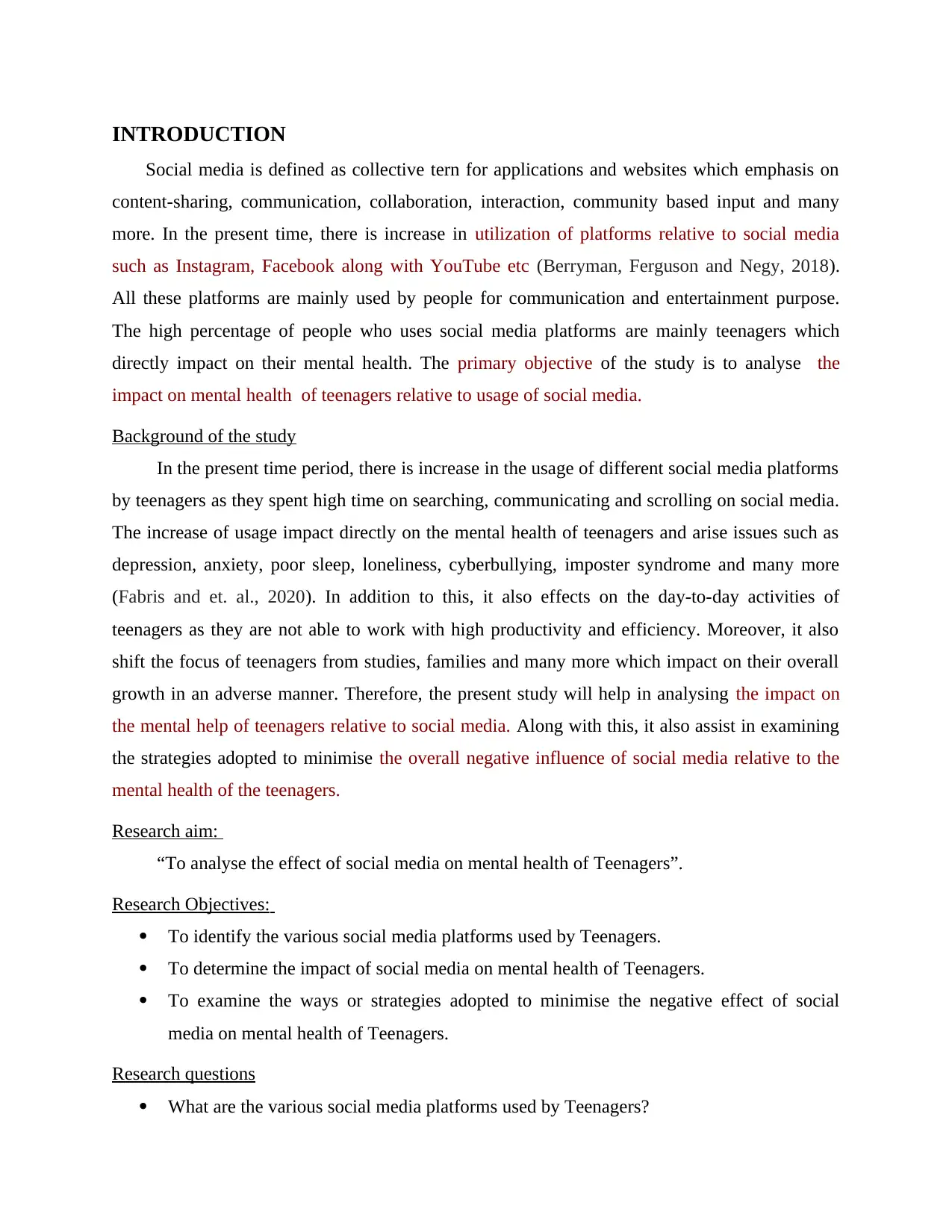
INTRODUCTION
Social media is defined as collective tern for applications and websites which emphasis on
content-sharing, communication, collaboration, interaction, community based input and many
more. In the present time, there is increase in utilization of platforms relative to social media
such as Instagram, Facebook along with YouTube etc (Berryman, Ferguson and Negy, 2018).
All these platforms are mainly used by people for communication and entertainment purpose.
The high percentage of people who uses social media platforms are mainly teenagers which
directly impact on their mental health. The primary objective of the study is to analyse the
impact on mental health of teenagers relative to usage of social media.
Background of the study
In the present time period, there is increase in the usage of different social media platforms
by teenagers as they spent high time on searching, communicating and scrolling on social media.
The increase of usage impact directly on the mental health of teenagers and arise issues such as
depression, anxiety, poor sleep, loneliness, cyberbullying, imposter syndrome and many more
(Fabris and et. al., 2020). In addition to this, it also effects on the day-to-day activities of
teenagers as they are not able to work with high productivity and efficiency. Moreover, it also
shift the focus of teenagers from studies, families and many more which impact on their overall
growth in an adverse manner. Therefore, the present study will help in analysing the impact on
the mental help of teenagers relative to social media. Along with this, it also assist in examining
the strategies adopted to minimise the overall negative influence of social media relative to the
mental health of the teenagers.
Research aim:
“To analyse the effect of social media on mental health of Teenagers”.
Research Objectives:
To identify the various social media platforms used by Teenagers.
To determine the impact of social media on mental health of Teenagers.
To examine the ways or strategies adopted to minimise the negative effect of social
media on mental health of Teenagers.
Research questions
What are the various social media platforms used by Teenagers?
Social media is defined as collective tern for applications and websites which emphasis on
content-sharing, communication, collaboration, interaction, community based input and many
more. In the present time, there is increase in utilization of platforms relative to social media
such as Instagram, Facebook along with YouTube etc (Berryman, Ferguson and Negy, 2018).
All these platforms are mainly used by people for communication and entertainment purpose.
The high percentage of people who uses social media platforms are mainly teenagers which
directly impact on their mental health. The primary objective of the study is to analyse the
impact on mental health of teenagers relative to usage of social media.
Background of the study
In the present time period, there is increase in the usage of different social media platforms
by teenagers as they spent high time on searching, communicating and scrolling on social media.
The increase of usage impact directly on the mental health of teenagers and arise issues such as
depression, anxiety, poor sleep, loneliness, cyberbullying, imposter syndrome and many more
(Fabris and et. al., 2020). In addition to this, it also effects on the day-to-day activities of
teenagers as they are not able to work with high productivity and efficiency. Moreover, it also
shift the focus of teenagers from studies, families and many more which impact on their overall
growth in an adverse manner. Therefore, the present study will help in analysing the impact on
the mental help of teenagers relative to social media. Along with this, it also assist in examining
the strategies adopted to minimise the overall negative influence of social media relative to the
mental health of the teenagers.
Research aim:
“To analyse the effect of social media on mental health of Teenagers”.
Research Objectives:
To identify the various social media platforms used by Teenagers.
To determine the impact of social media on mental health of Teenagers.
To examine the ways or strategies adopted to minimise the negative effect of social
media on mental health of Teenagers.
Research questions
What are the various social media platforms used by Teenagers?
⊘ This is a preview!⊘
Do you want full access?
Subscribe today to unlock all pages.

Trusted by 1+ million students worldwide
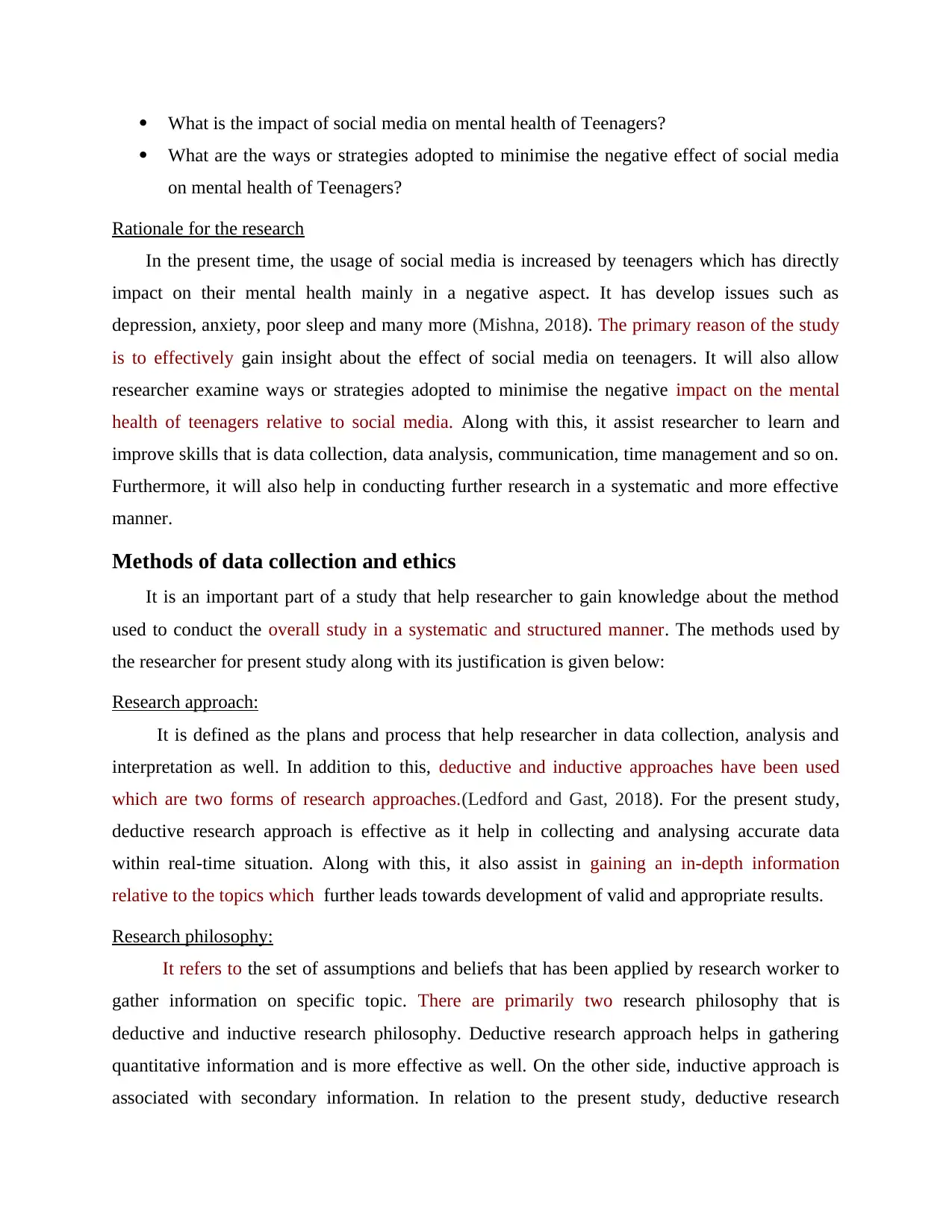
What is the impact of social media on mental health of Teenagers?
What are the ways or strategies adopted to minimise the negative effect of social media
on mental health of Teenagers?
Rationale for the research
In the present time, the usage of social media is increased by teenagers which has directly
impact on their mental health mainly in a negative aspect. It has develop issues such as
depression, anxiety, poor sleep and many more (Mishna, 2018). The primary reason of the study
is to effectively gain insight about the effect of social media on teenagers. It will also allow
researcher examine ways or strategies adopted to minimise the negative impact on the mental
health of teenagers relative to social media. Along with this, it assist researcher to learn and
improve skills that is data collection, data analysis, communication, time management and so on.
Furthermore, it will also help in conducting further research in a systematic and more effective
manner.
Methods of data collection and ethics
It is an important part of a study that help researcher to gain knowledge about the method
used to conduct the overall study in a systematic and structured manner. The methods used by
the researcher for present study along with its justification is given below:
Research approach:
It is defined as the plans and process that help researcher in data collection, analysis and
interpretation as well. In addition to this, deductive and inductive approaches have been used
which are two forms of research approaches.(Ledford and Gast, 2018). For the present study,
deductive research approach is effective as it help in collecting and analysing accurate data
within real-time situation. Along with this, it also assist in gaining an in-depth information
relative to the topics which further leads towards development of valid and appropriate results.
Research philosophy:
It refers to the set of assumptions and beliefs that has been applied by research worker to
gather information on specific topic. There are primarily two research philosophy that is
deductive and inductive research philosophy. Deductive research approach helps in gathering
quantitative information and is more effective as well. On the other side, inductive approach is
associated with secondary information. In relation to the present study, deductive research
What are the ways or strategies adopted to minimise the negative effect of social media
on mental health of Teenagers?
Rationale for the research
In the present time, the usage of social media is increased by teenagers which has directly
impact on their mental health mainly in a negative aspect. It has develop issues such as
depression, anxiety, poor sleep and many more (Mishna, 2018). The primary reason of the study
is to effectively gain insight about the effect of social media on teenagers. It will also allow
researcher examine ways or strategies adopted to minimise the negative impact on the mental
health of teenagers relative to social media. Along with this, it assist researcher to learn and
improve skills that is data collection, data analysis, communication, time management and so on.
Furthermore, it will also help in conducting further research in a systematic and more effective
manner.
Methods of data collection and ethics
It is an important part of a study that help researcher to gain knowledge about the method
used to conduct the overall study in a systematic and structured manner. The methods used by
the researcher for present study along with its justification is given below:
Research approach:
It is defined as the plans and process that help researcher in data collection, analysis and
interpretation as well. In addition to this, deductive and inductive approaches have been used
which are two forms of research approaches.(Ledford and Gast, 2018). For the present study,
deductive research approach is effective as it help in collecting and analysing accurate data
within real-time situation. Along with this, it also assist in gaining an in-depth information
relative to the topics which further leads towards development of valid and appropriate results.
Research philosophy:
It refers to the set of assumptions and beliefs that has been applied by research worker to
gather information on specific topic. There are primarily two research philosophy that is
deductive and inductive research philosophy. Deductive research approach helps in gathering
quantitative information and is more effective as well. On the other side, inductive approach is
associated with secondary information. In relation to the present study, deductive research
Paraphrase This Document
Need a fresh take? Get an instant paraphrase of this document with our AI Paraphraser
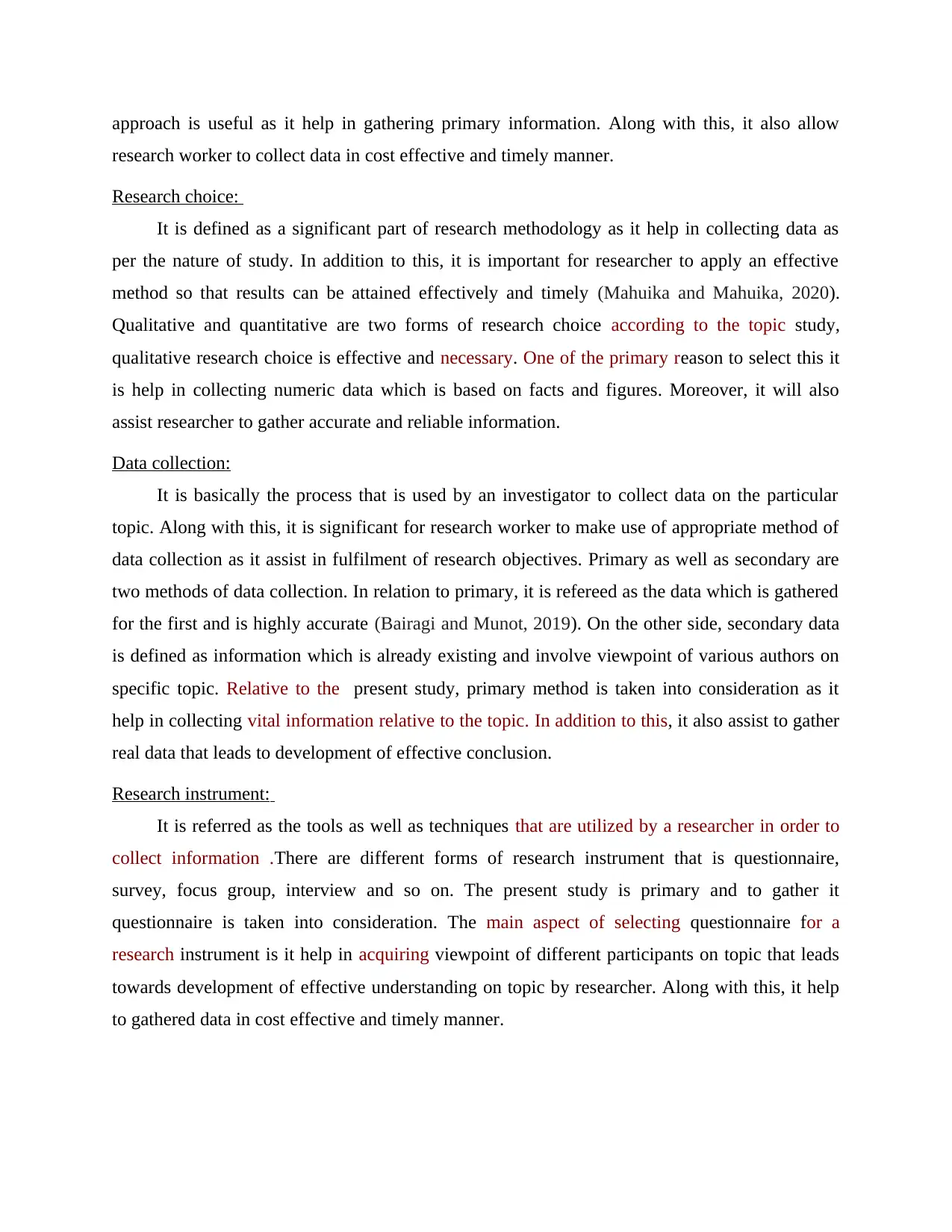
approach is useful as it help in gathering primary information. Along with this, it also allow
research worker to collect data in cost effective and timely manner.
Research choice:
It is defined as a significant part of research methodology as it help in collecting data as
per the nature of study. In addition to this, it is important for researcher to apply an effective
method so that results can be attained effectively and timely (Mahuika and Mahuika, 2020).
Qualitative and quantitative are two forms of research choice according to the topic study,
qualitative research choice is effective and necessary. One of the primary reason to select this it
is help in collecting numeric data which is based on facts and figures. Moreover, it will also
assist researcher to gather accurate and reliable information.
Data collection:
It is basically the process that is used by an investigator to collect data on the particular
topic. Along with this, it is significant for research worker to make use of appropriate method of
data collection as it assist in fulfilment of research objectives. Primary as well as secondary are
two methods of data collection. In relation to primary, it is refereed as the data which is gathered
for the first and is highly accurate (Bairagi and Munot, 2019). On the other side, secondary data
is defined as information which is already existing and involve viewpoint of various authors on
specific topic. Relative to the present study, primary method is taken into consideration as it
help in collecting vital information relative to the topic. In addition to this, it also assist to gather
real data that leads to development of effective conclusion.
Research instrument:
It is referred as the tools as well as techniques that are utilized by a researcher in order to
collect information .There are different forms of research instrument that is questionnaire,
survey, focus group, interview and so on. The present study is primary and to gather it
questionnaire is taken into consideration. The main aspect of selecting questionnaire for a
research instrument is it help in acquiring viewpoint of different participants on topic that leads
towards development of effective understanding on topic by researcher. Along with this, it help
to gathered data in cost effective and timely manner.
research worker to collect data in cost effective and timely manner.
Research choice:
It is defined as a significant part of research methodology as it help in collecting data as
per the nature of study. In addition to this, it is important for researcher to apply an effective
method so that results can be attained effectively and timely (Mahuika and Mahuika, 2020).
Qualitative and quantitative are two forms of research choice according to the topic study,
qualitative research choice is effective and necessary. One of the primary reason to select this it
is help in collecting numeric data which is based on facts and figures. Moreover, it will also
assist researcher to gather accurate and reliable information.
Data collection:
It is basically the process that is used by an investigator to collect data on the particular
topic. Along with this, it is significant for research worker to make use of appropriate method of
data collection as it assist in fulfilment of research objectives. Primary as well as secondary are
two methods of data collection. In relation to primary, it is refereed as the data which is gathered
for the first and is highly accurate (Bairagi and Munot, 2019). On the other side, secondary data
is defined as information which is already existing and involve viewpoint of various authors on
specific topic. Relative to the present study, primary method is taken into consideration as it
help in collecting vital information relative to the topic. In addition to this, it also assist to gather
real data that leads to development of effective conclusion.
Research instrument:
It is referred as the tools as well as techniques that are utilized by a researcher in order to
collect information .There are different forms of research instrument that is questionnaire,
survey, focus group, interview and so on. The present study is primary and to gather it
questionnaire is taken into consideration. The main aspect of selecting questionnaire for a
research instrument is it help in acquiring viewpoint of different participants on topic that leads
towards development of effective understanding on topic by researcher. Along with this, it help
to gathered data in cost effective and timely manner.
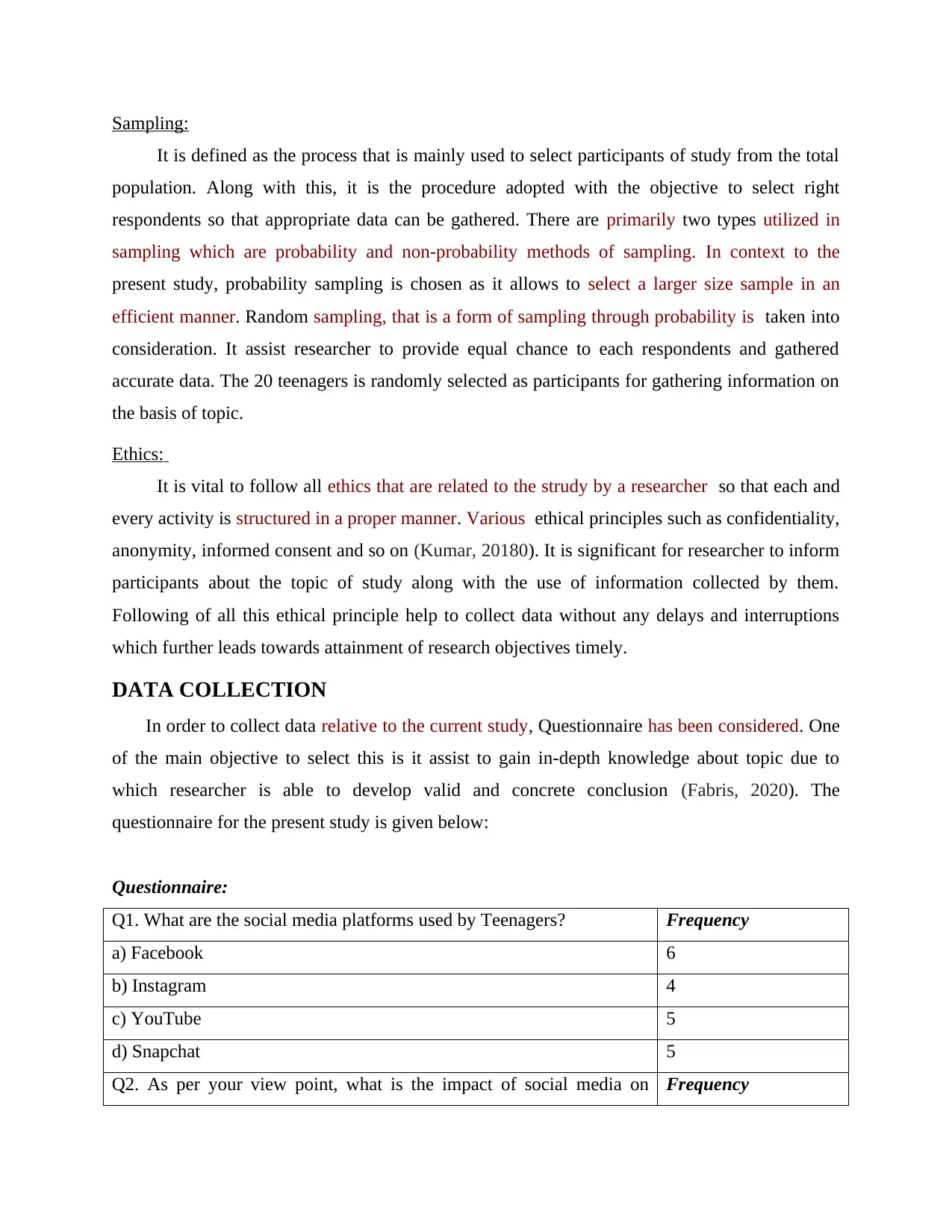
Sampling:
It is defined as the process that is mainly used to select participants of study from the total
population. Along with this, it is the procedure adopted with the objective to select right
respondents so that appropriate data can be gathered. There are primarily two types utilized in
sampling which are probability and non-probability methods of sampling. In context to the
present study, probability sampling is chosen as it allows to select a larger size sample in an
efficient manner. Random sampling, that is a form of sampling through probability is taken into
consideration. It assist researcher to provide equal chance to each respondents and gathered
accurate data. The 20 teenagers is randomly selected as participants for gathering information on
the basis of topic.
Ethics:
It is vital to follow all ethics that are related to the strudy by a researcher so that each and
every activity is structured in a proper manner. Various ethical principles such as confidentiality,
anonymity, informed consent and so on (Kumar, 20180). It is significant for researcher to inform
participants about the topic of study along with the use of information collected by them.
Following of all this ethical principle help to collect data without any delays and interruptions
which further leads towards attainment of research objectives timely.
DATA COLLECTION
In order to collect data relative to the current study, Questionnaire has been considered. One
of the main objective to select this is it assist to gain in-depth knowledge about topic due to
which researcher is able to develop valid and concrete conclusion (Fabris, 2020). The
questionnaire for the present study is given below:
Questionnaire:
Q1. What are the social media platforms used by Teenagers? Frequency
a) Facebook 6
b) Instagram 4
c) YouTube 5
d) Snapchat 5
Q2. As per your view point, what is the impact of social media on Frequency
It is defined as the process that is mainly used to select participants of study from the total
population. Along with this, it is the procedure adopted with the objective to select right
respondents so that appropriate data can be gathered. There are primarily two types utilized in
sampling which are probability and non-probability methods of sampling. In context to the
present study, probability sampling is chosen as it allows to select a larger size sample in an
efficient manner. Random sampling, that is a form of sampling through probability is taken into
consideration. It assist researcher to provide equal chance to each respondents and gathered
accurate data. The 20 teenagers is randomly selected as participants for gathering information on
the basis of topic.
Ethics:
It is vital to follow all ethics that are related to the strudy by a researcher so that each and
every activity is structured in a proper manner. Various ethical principles such as confidentiality,
anonymity, informed consent and so on (Kumar, 20180). It is significant for researcher to inform
participants about the topic of study along with the use of information collected by them.
Following of all this ethical principle help to collect data without any delays and interruptions
which further leads towards attainment of research objectives timely.
DATA COLLECTION
In order to collect data relative to the current study, Questionnaire has been considered. One
of the main objective to select this is it assist to gain in-depth knowledge about topic due to
which researcher is able to develop valid and concrete conclusion (Fabris, 2020). The
questionnaire for the present study is given below:
Questionnaire:
Q1. What are the social media platforms used by Teenagers? Frequency
a) Facebook 6
b) Instagram 4
c) YouTube 5
d) Snapchat 5
Q2. As per your view point, what is the impact of social media on Frequency
⊘ This is a preview!⊘
Do you want full access?
Subscribe today to unlock all pages.

Trusted by 1+ million students worldwide
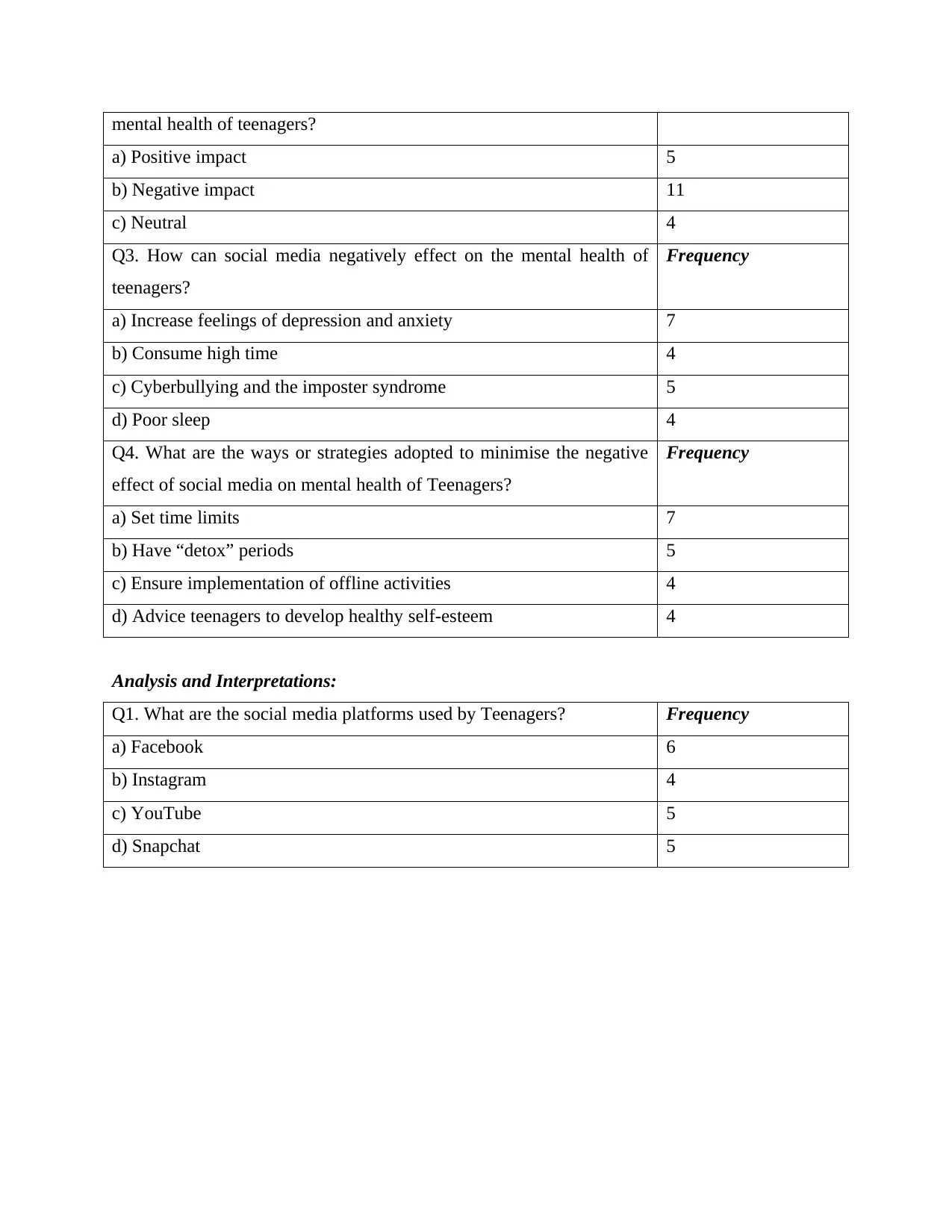
mental health of teenagers?
a) Positive impact 5
b) Negative impact 11
c) Neutral 4
Q3. How can social media negatively effect on the mental health of
teenagers?
Frequency
a) Increase feelings of depression and anxiety 7
b) Consume high time 4
c) Cyberbullying and the imposter syndrome 5
d) Poor sleep 4
Q4. What are the ways or strategies adopted to minimise the negative
effect of social media on mental health of Teenagers?
Frequency
a) Set time limits 7
b) Have “detox” periods 5
c) Ensure implementation of offline activities 4
d) Advice teenagers to develop healthy self-esteem 4
Analysis and Interpretations:
Q1. What are the social media platforms used by Teenagers? Frequency
a) Facebook 6
b) Instagram 4
c) YouTube 5
d) Snapchat 5
a) Positive impact 5
b) Negative impact 11
c) Neutral 4
Q3. How can social media negatively effect on the mental health of
teenagers?
Frequency
a) Increase feelings of depression and anxiety 7
b) Consume high time 4
c) Cyberbullying and the imposter syndrome 5
d) Poor sleep 4
Q4. What are the ways or strategies adopted to minimise the negative
effect of social media on mental health of Teenagers?
Frequency
a) Set time limits 7
b) Have “detox” periods 5
c) Ensure implementation of offline activities 4
d) Advice teenagers to develop healthy self-esteem 4
Analysis and Interpretations:
Q1. What are the social media platforms used by Teenagers? Frequency
a) Facebook 6
b) Instagram 4
c) YouTube 5
d) Snapchat 5
Paraphrase This Document
Need a fresh take? Get an instant paraphrase of this document with our AI Paraphraser
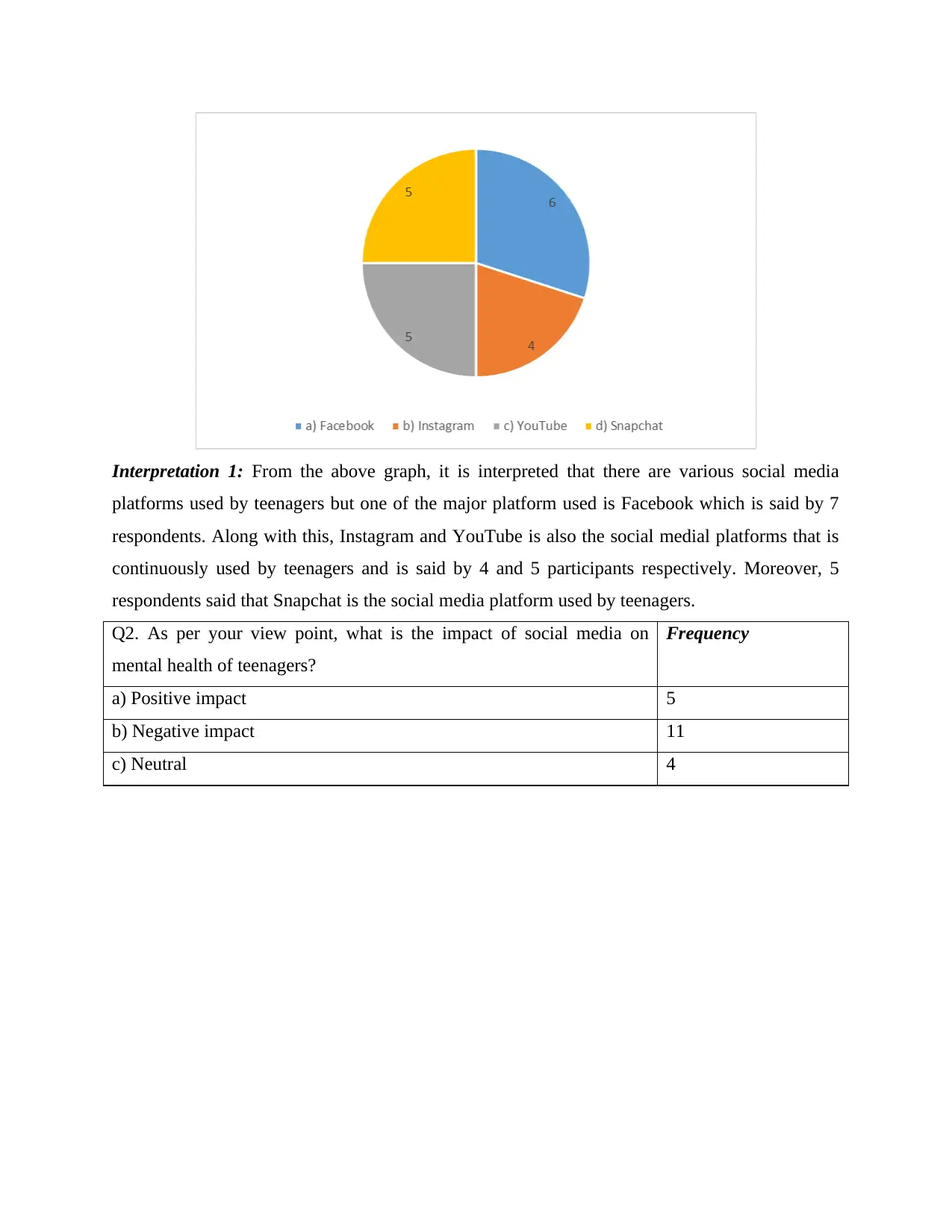
Interpretation 1: From the above graph, it is interpreted that there are various social media
platforms used by teenagers but one of the major platform used is Facebook which is said by 7
respondents. Along with this, Instagram and YouTube is also the social medial platforms that is
continuously used by teenagers and is said by 4 and 5 participants respectively. Moreover, 5
respondents said that Snapchat is the social media platform used by teenagers.
Q2. As per your view point, what is the impact of social media on
mental health of teenagers?
Frequency
a) Positive impact 5
b) Negative impact 11
c) Neutral 4
platforms used by teenagers but one of the major platform used is Facebook which is said by 7
respondents. Along with this, Instagram and YouTube is also the social medial platforms that is
continuously used by teenagers and is said by 4 and 5 participants respectively. Moreover, 5
respondents said that Snapchat is the social media platform used by teenagers.
Q2. As per your view point, what is the impact of social media on
mental health of teenagers?
Frequency
a) Positive impact 5
b) Negative impact 11
c) Neutral 4
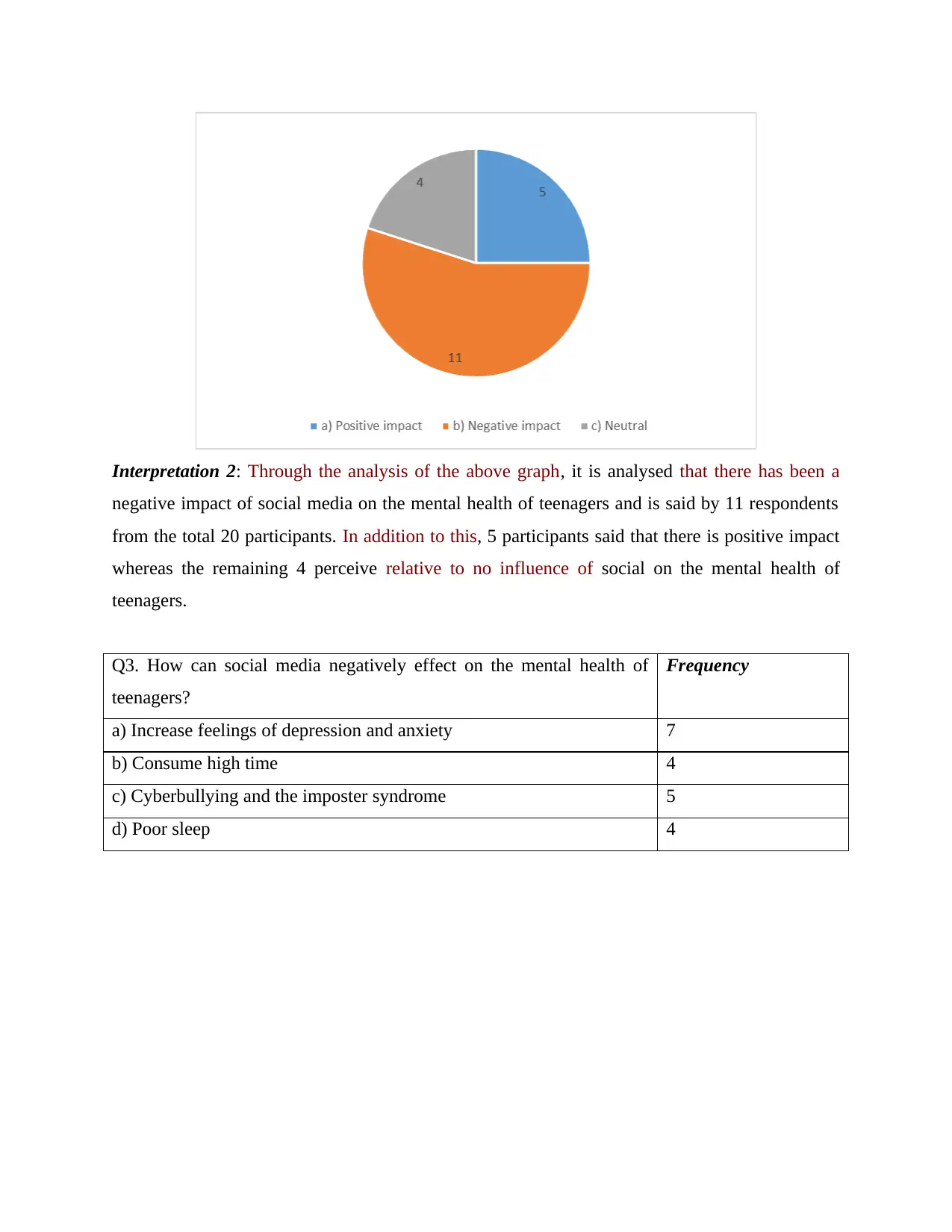
Interpretation 2: Through the analysis of the above graph, it is analysed that there has been a
negative impact of social media on the mental health of teenagers and is said by 11 respondents
from the total 20 participants. In addition to this, 5 participants said that there is positive impact
whereas the remaining 4 perceive relative to no influence of social on the mental health of
teenagers.
Q3. How can social media negatively effect on the mental health of
teenagers?
Frequency
a) Increase feelings of depression and anxiety 7
b) Consume high time 4
c) Cyberbullying and the imposter syndrome 5
d) Poor sleep 4
negative impact of social media on the mental health of teenagers and is said by 11 respondents
from the total 20 participants. In addition to this, 5 participants said that there is positive impact
whereas the remaining 4 perceive relative to no influence of social on the mental health of
teenagers.
Q3. How can social media negatively effect on the mental health of
teenagers?
Frequency
a) Increase feelings of depression and anxiety 7
b) Consume high time 4
c) Cyberbullying and the imposter syndrome 5
d) Poor sleep 4
⊘ This is a preview!⊘
Do you want full access?
Subscribe today to unlock all pages.

Trusted by 1+ million students worldwide
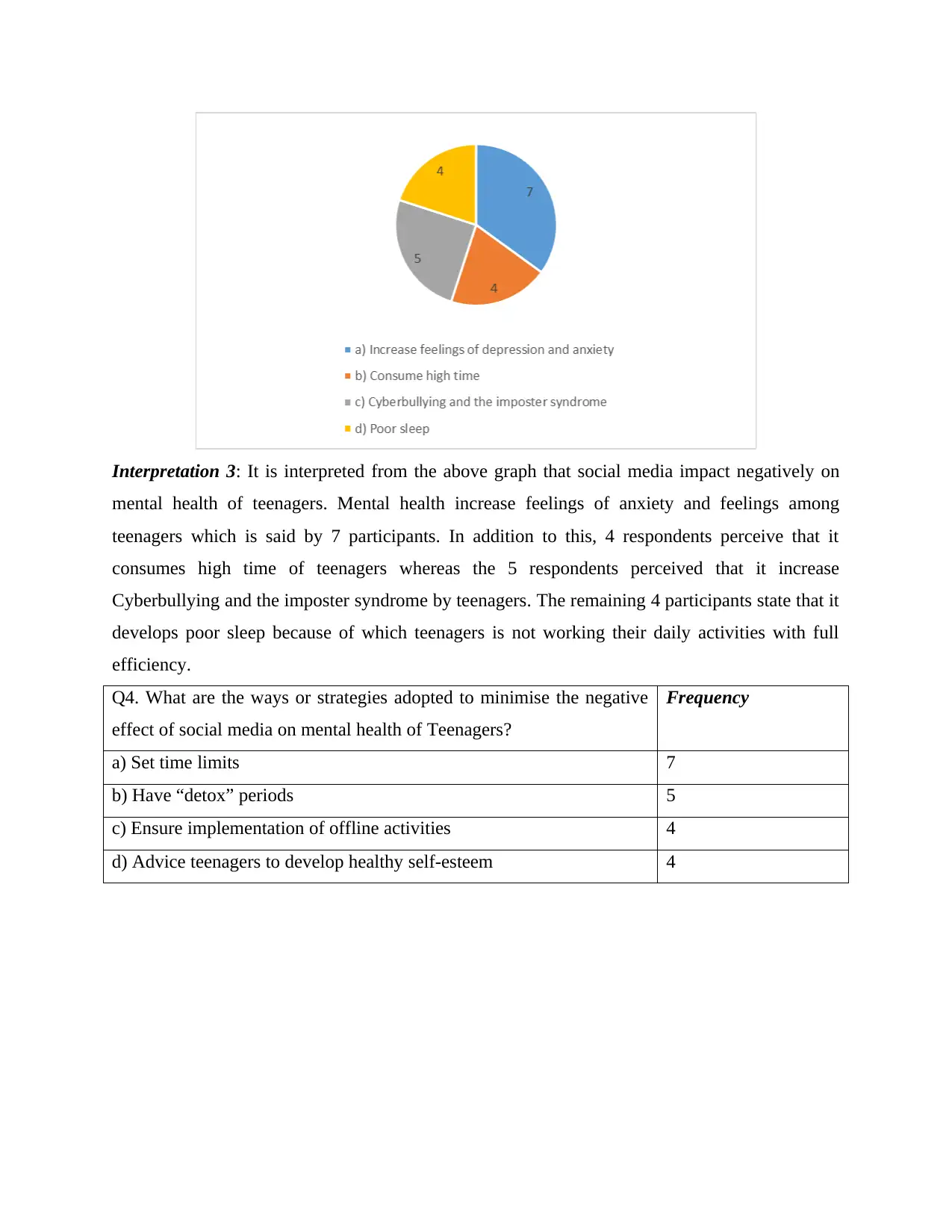
Interpretation 3: It is interpreted from the above graph that social media impact negatively on
mental health of teenagers. Mental health increase feelings of anxiety and feelings among
teenagers which is said by 7 participants. In addition to this, 4 respondents perceive that it
consumes high time of teenagers whereas the 5 respondents perceived that it increase
Cyberbullying and the imposter syndrome by teenagers. The remaining 4 participants state that it
develops poor sleep because of which teenagers is not working their daily activities with full
efficiency.
Q4. What are the ways or strategies adopted to minimise the negative
effect of social media on mental health of Teenagers?
Frequency
a) Set time limits 7
b) Have “detox” periods 5
c) Ensure implementation of offline activities 4
d) Advice teenagers to develop healthy self-esteem 4
mental health of teenagers. Mental health increase feelings of anxiety and feelings among
teenagers which is said by 7 participants. In addition to this, 4 respondents perceive that it
consumes high time of teenagers whereas the 5 respondents perceived that it increase
Cyberbullying and the imposter syndrome by teenagers. The remaining 4 participants state that it
develops poor sleep because of which teenagers is not working their daily activities with full
efficiency.
Q4. What are the ways or strategies adopted to minimise the negative
effect of social media on mental health of Teenagers?
Frequency
a) Set time limits 7
b) Have “detox” periods 5
c) Ensure implementation of offline activities 4
d) Advice teenagers to develop healthy self-esteem 4
Paraphrase This Document
Need a fresh take? Get an instant paraphrase of this document with our AI Paraphraser
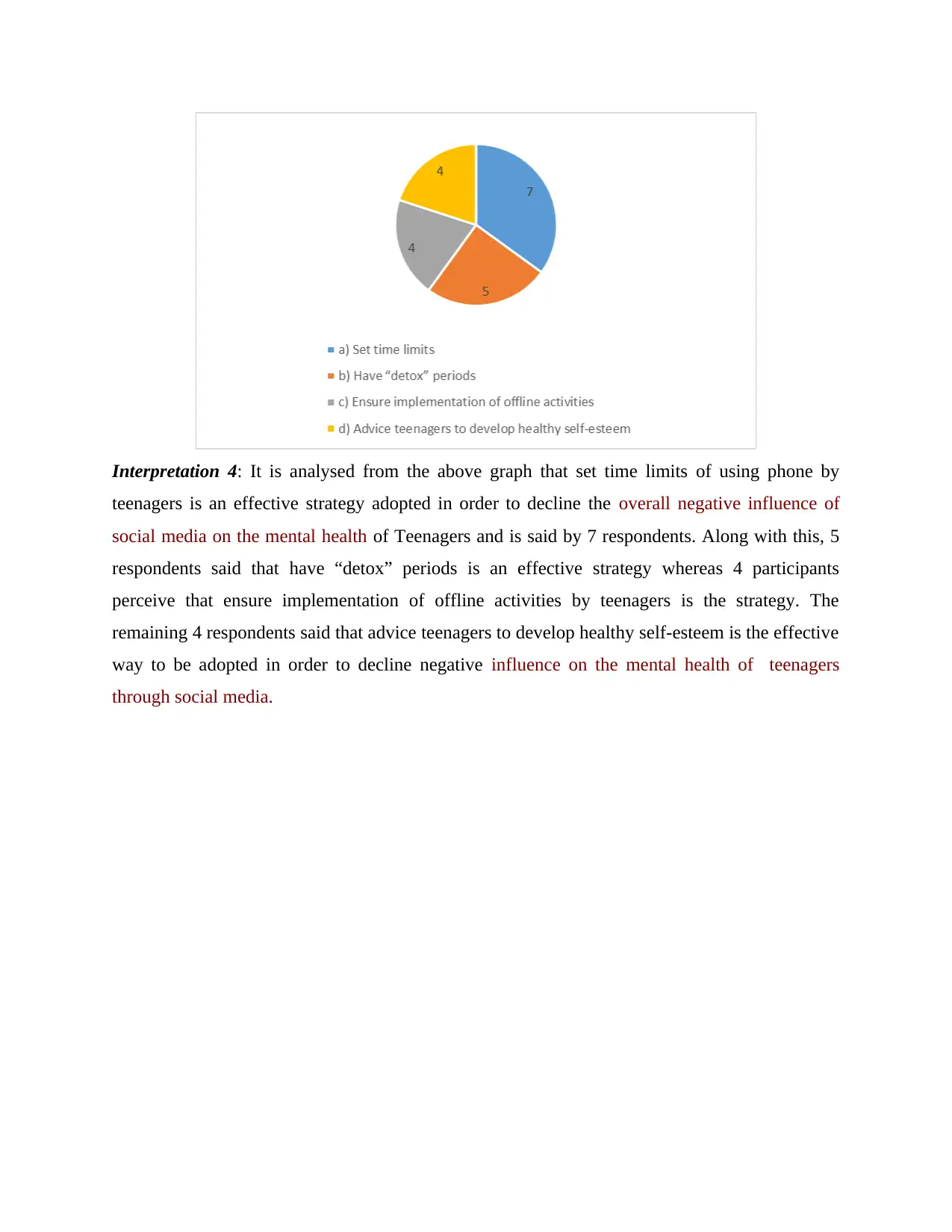
Interpretation 4: It is analysed from the above graph that set time limits of using phone by
teenagers is an effective strategy adopted in order to decline the overall negative influence of
social media on the mental health of Teenagers and is said by 7 respondents. Along with this, 5
respondents said that have “detox” periods is an effective strategy whereas 4 participants
perceive that ensure implementation of offline activities by teenagers is the strategy. The
remaining 4 respondents said that advice teenagers to develop healthy self-esteem is the effective
way to be adopted in order to decline negative influence on the mental health of teenagers
through social media.
teenagers is an effective strategy adopted in order to decline the overall negative influence of
social media on the mental health of Teenagers and is said by 7 respondents. Along with this, 5
respondents said that have “detox” periods is an effective strategy whereas 4 participants
perceive that ensure implementation of offline activities by teenagers is the strategy. The
remaining 4 respondents said that advice teenagers to develop healthy self-esteem is the effective
way to be adopted in order to decline negative influence on the mental health of teenagers
through social media.
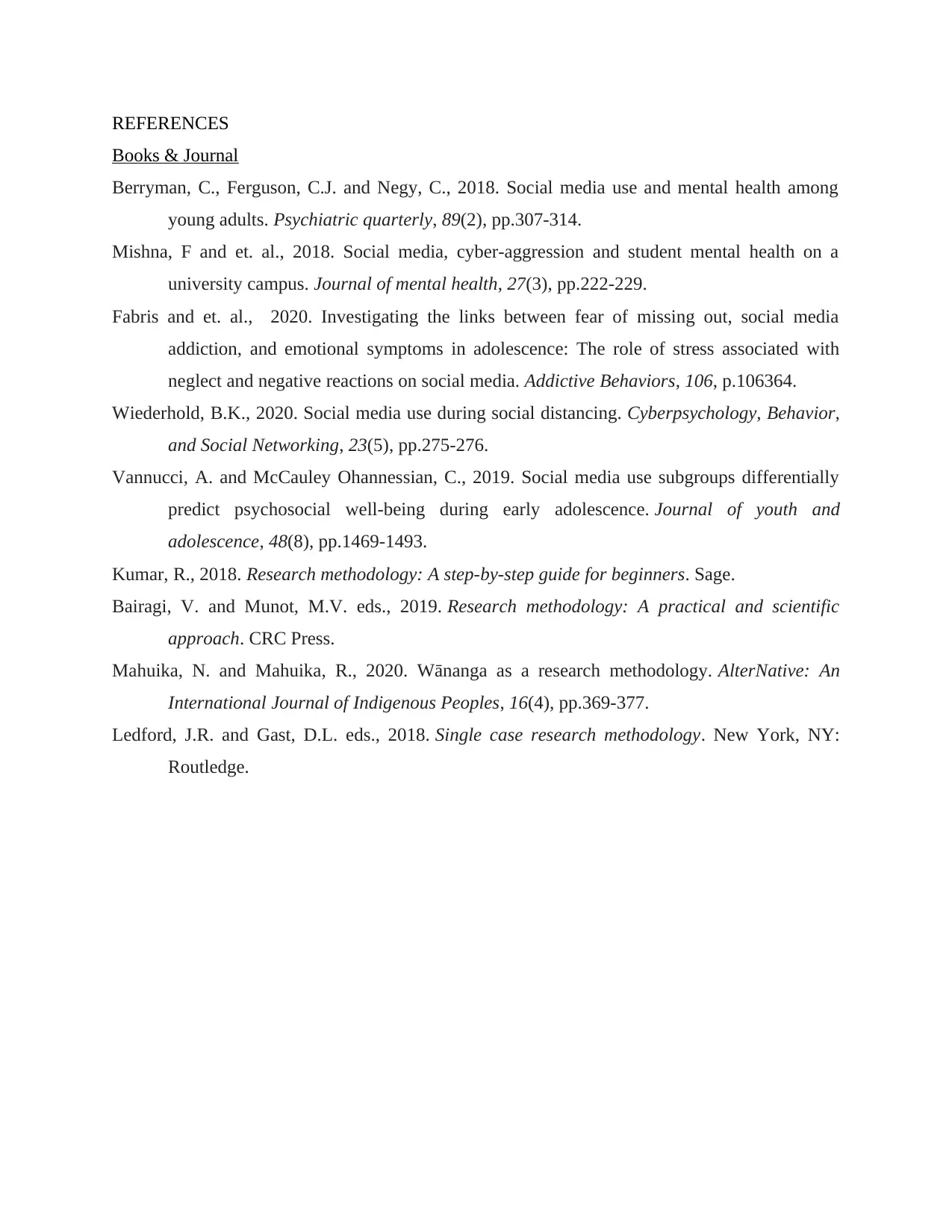
REFERENCES
Books & Journal
Berryman, C., Ferguson, C.J. and Negy, C., 2018. Social media use and mental health among
young adults. Psychiatric quarterly, 89(2), pp.307-314.
Mishna, F and et. al., 2018. Social media, cyber-aggression and student mental health on a
university campus. Journal of mental health, 27(3), pp.222-229.
Fabris and et. al., 2020. Investigating the links between fear of missing out, social media
addiction, and emotional symptoms in adolescence: The role of stress associated with
neglect and negative reactions on social media. Addictive Behaviors, 106, p.106364.
Wiederhold, B.K., 2020. Social media use during social distancing. Cyberpsychology, Behavior,
and Social Networking, 23(5), pp.275-276.
Vannucci, A. and McCauley Ohannessian, C., 2019. Social media use subgroups differentially
predict psychosocial well-being during early adolescence. Journal of youth and
adolescence, 48(8), pp.1469-1493.
Kumar, R., 2018. Research methodology: A step-by-step guide for beginners. Sage.
Bairagi, V. and Munot, M.V. eds., 2019. Research methodology: A practical and scientific
approach. CRC Press.
Mahuika, N. and Mahuika, R., 2020. Wānanga as a research methodology. AlterNative: An
International Journal of Indigenous Peoples, 16(4), pp.369-377.
Ledford, J.R. and Gast, D.L. eds., 2018. Single case research methodology. New York, NY:
Routledge.
Books & Journal
Berryman, C., Ferguson, C.J. and Negy, C., 2018. Social media use and mental health among
young adults. Psychiatric quarterly, 89(2), pp.307-314.
Mishna, F and et. al., 2018. Social media, cyber-aggression and student mental health on a
university campus. Journal of mental health, 27(3), pp.222-229.
Fabris and et. al., 2020. Investigating the links between fear of missing out, social media
addiction, and emotional symptoms in adolescence: The role of stress associated with
neglect and negative reactions on social media. Addictive Behaviors, 106, p.106364.
Wiederhold, B.K., 2020. Social media use during social distancing. Cyberpsychology, Behavior,
and Social Networking, 23(5), pp.275-276.
Vannucci, A. and McCauley Ohannessian, C., 2019. Social media use subgroups differentially
predict psychosocial well-being during early adolescence. Journal of youth and
adolescence, 48(8), pp.1469-1493.
Kumar, R., 2018. Research methodology: A step-by-step guide for beginners. Sage.
Bairagi, V. and Munot, M.V. eds., 2019. Research methodology: A practical and scientific
approach. CRC Press.
Mahuika, N. and Mahuika, R., 2020. Wānanga as a research methodology. AlterNative: An
International Journal of Indigenous Peoples, 16(4), pp.369-377.
Ledford, J.R. and Gast, D.L. eds., 2018. Single case research methodology. New York, NY:
Routledge.
⊘ This is a preview!⊘
Do you want full access?
Subscribe today to unlock all pages.

Trusted by 1+ million students worldwide
1 out of 13
Related Documents
Your All-in-One AI-Powered Toolkit for Academic Success.
+13062052269
info@desklib.com
Available 24*7 on WhatsApp / Email
![[object Object]](/_next/static/media/star-bottom.7253800d.svg)
Unlock your academic potential
Copyright © 2020–2025 A2Z Services. All Rights Reserved. Developed and managed by ZUCOL.



